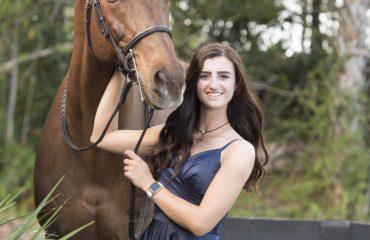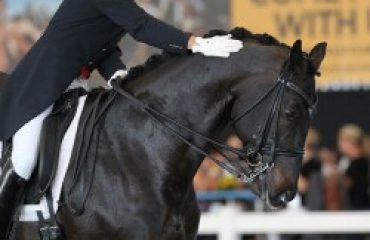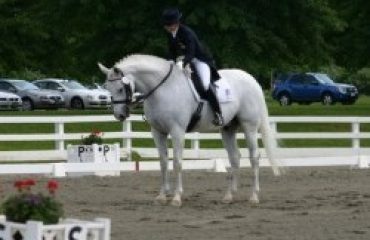
By Shya Beth
Residing in René, a small village in Sarthe, northwest France, Véronique Lesage has a love of horses and passion for art that have intertwined into a force of creativity. Many times, passions and interests are discovered as a child, and Véronique’s beginnings are not different in that respect. Her calligraphic paintings, however, uniquely encapsulate the energy and life of horses through her expressive use of Chinese and Japanese calligraphy-inspired techniques.

“My grandparents were farmers, and every vacation my sister and I liked to help harvest hay and feed the farm animals,” Véronique said. “Of course, my grandparents had draft horses, and we would ride on them and pet them. This proximity has certainly had an impact on my love of animals, and horses in particular.”
In 1978 Véronique continued to combine her two passions while attending École Supérieure Estienne in Paris, a renowned art school where she studied graphic design. The equine figure, something she had been familiar with since her childhood, was again a central theme in her study. She chose the theme of the harnessed horse for her display for her final presentation at the school in order to receive her diploma, which was a wonderful success. Véronique graduated and took on several graphic design internships, but decided shortly afterward to change direction to sales, first doing door-to-door sales and then working as a saleswoman for household appliances in a department store—while continuing to draw and create on the side.
Many years later, in 1996, Véronique couldn’t resist the call of her true passion. She returned to her first love and quit her sales career to become a painter. At the end of that year, she had her first major exhibit at the Salon Du Cheval, a major horse fair and trade show that takes place in the heart of Paris. Almost 30 years later, the adventure has only continued.

Painting the Equine Spirit
“I love the horse: for its beauty, elegance, presence, for what it truly is. I don’t feel the need to ride them; I prefer to watch them at liberty, playing or competing—just taking in their movement and beauty. Aside from my own original paintings and artistic explorations, I create portraits and ‘trophies’—paintings for winners of regional horse shows,” Véronique said. “With my way of painting, of bringing the spirit to life while maintaining physical accuracy of the horse’s figure and movement, many professionals from the equestrian world have fallen in love with my style.”
When Véronique first started as a professional painter, there were very few animal artists specializing in horses in France. Veronique has become well established in France as a premier equine artist among the few that depict horses in a calligraphic and gestural way.
“Like any artist, I have a recognizable legacy,” she said. “I try to translate the horse’s strength and presence not only in my drawings or ink, but in sculpture as well. I really like working with ink with a goose quill, like calligraphy. Similar to writing, the pen twists, wrinkles, crushes on the paper, offering fluid curves with full and smooth strokes—the perfect tool to translate the energy of the horse, to my taste. These are traditionally writing tools that, for me, allow me to feel the horse right through my fingertips and bring out what I feel on the canvas or paper.”

Ancient Work to Present Day
The earliest examples of Chinese calligraphy date back to the Shang dynasty, which was around 1600–1100 B.C., and calligraphy was introduced to Japanese culture in the sixth century. While these writing forms may be ancient, they are still used—and inspiring modern artists—today. Véronique’s style of using elements of Japanese and Chinese calligraphy offer a new way to explore color, depth, movement and style. Rapid gestures are a signature part of calligraphy, which Véronique uses to tell the story of energy and movement of the horse. The different inks and tools work perfectly for translating the roundness, lightness and flexibility of the horse onto paper, bringing them to life. While many describe her work as graphic, figurative and almost, but not completely, abstract, Véronique’s paintings focus on what she calls the “lines of force”—the essential lines that simply translate the horse’s elegance or its character.
Veronique is finding that sculpture is the next step in her artistic evolution, considering it to be “the three-dimensional rendition” of her paintings. While movement and focus on aesthetics is key in her work, her sculptures are a way to bring the calligraphic principle to life without losing the free-flowing movement that her paintings and drawings are known for.
“As an artist, every day is a bit the same,” she said. “Always needing to sketch and renew the creative process. But at the same time, every day is a little different. I draw, I sketch, I sculpt, I have ideas for new sculptures and discuss them with other artists and creative minds. I’m working on creating metal sculptures and graphic trophies, and already have some ideas for those, which have been brewing for some time. Because that is the driving force of every artist: Creating, dreaming of our future; that is what makes us come alive! Horses have always been a passion, but they are my driving force.”
For more information, visit veronique-lesage-artiste.com















